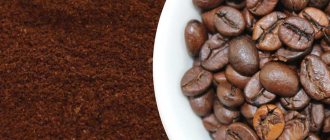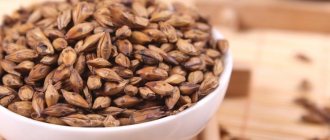A truly delicate bouquet of an aromatic drink can only be felt when coffee is prepared from fresh beans. To do this, the beans need to be brewed correctly and, equally important, carefully and carefully stored so that they do not lose their unique aroma. Experienced coffee lovers know how difficult it is to preserve the true noble taste, avoiding bitterness or acid, so we have put together a reminder for all lovers of the golden drink on how to keep coffee fresh at home.
Why does coffee go bad?
It is known that coffee beans are a raw material rich in vitamin and mineral complexes, which also contains antioxidants and essential oils. Under the influence of external factors, these compounds quickly disintegrate, which is why fragrant grains lose their unique taste and aromatic qualities.
The following have a harmful effect on fresh coffee raw materials:
- sunlight and direct light;
- moisture in the air;
- oxygen;
- temperature changes;
- foreign odors.
When temperatures fluctuate or when heated, freshly roasted coffee releases vapors and carbon dioxide, causing condensation to form. In open air and light, coffee powder oxidizes and loses its beneficial properties. In addition, the organoleptic picture is disrupted - coffee may become tasteless, unpleasant bitterness, acidity, dusty or metallic taste will appear.
Another distinctive property of coffee is its hygroscopicity. Many may have heard that an appetizing smell kills other aromas, so it is often offered in perfume stores as a “filter” for other odors. Coffee, especially ground into powder, should not be placed next to strong-smelling products, if the raw materials are still going to be brewed - it will absorb foreign impurities, which will make the drink tasteless.
In order for dry coffee to retain its subtle rich aroma, it must be properly stored in accordance with the specifics of the raw material.
Storing Green Beans
Fresh coffee beans that have not yet been roasted must be protected from moisture so that the product does not become moldy or ferment. Storage in the freezer is acceptable. Such grains need a constant temperature, so it is advisable to store them in a well-ventilated area to eliminate the possibility of condensation and other unpleasant consequences.
Heat treatment is allowed to avoid product spoilage. To do this, the beans are dried at a low temperature - no more than 40°C in a slightly open oven. But such handling of the product requires experience so as not to spoil the entire batch - the required condition is very subtle. For an experiment, you can start with a small portion of grains and repeat the procedure only if the experiment is a success.
Such grains can be stored for no more than a couple of months.
Storing Roasted Beans
Classic roasted coffee, which can be purchased in specialized shops, ordered online or brought from distant countries, is a product prepared by the manufacturer for consumption. As a rule, coffee is so expensive that not a single manufacturer would dare to package the product poorly: almost every modern pack is equipped with a special valve for “breathing” the beans.
Roasted grains emit carbon dioxide for some time after processing and normally retain a certain degree of moisture. To do this, one-sided partitions are used, which allow gas to leave the package, but prevent harmful oxygen from penetrating into it. Thanks to such valves, there is an additional opportunity to feel the aroma of coffee even before purchasing it.
Keeping your coffee in a ziplock bag is the best option. In this case, it is necessary to release excess air from the bag. When it comes to a large supply, it is better to have a tabletop jar and update the available supply every week or two, without touching the total mass of fragrant coffee every day.
Storage in grains is the best option for extending the shelf life of the product. By being sealed in its own crusted beans, the coffee stays fresh and tastes good longer while the ground product stales out. Therefore, it is advisable to grind coffee once a week - for the next supply, and even better - before each brew. Although some experts argue that the coffee should still be allowed to open and not be brewed immediately after grinding.
Thus, it is best to store coffee in a foil bag - with or without a valve, at a neutral temperature - not over the stove or in the refrigerator. You can use a glass or ceramic jar with a tight-fitting top, but avoid plastic bags.
The shelf life of open packaging is about 2–4 months, closed – up to 6–8.
Video:
benefits of coffee Expand
Suitable conditions and terms
The optimal conditions and shelf life of coffee beans depend on their type, country of origin and method of roasting the product.
| Type of coffee | Package | 0º- — 20º | +13º — + 16º | +20º — + 35º |
| Grain | Closed | 1.5 years | 1 year | 6 months |
| Open | 2 months | 10 days | 24 hours | |
| Ground | Closed | 2-3 years | 6 months – 1.5 years | 4-6 months |
| Open | 3-4 weeks | 10-14 days | 5 days | |
| Soluble | Closed | 5 years | 3 years | 1-1.5 years |
| Open | 1 year | 4-6 months | 10-11 months |
More recently, a new type of product has appeared - capsules for brewing an aromatic drink. Capsules for making coffee are not allowed to be stored for more than 12 months; after this period they are considered unfit for consumption.
When kept in the wrong conditions, the beans oxidize and aromatic compounds evaporate, causing the invigorating drink to lose its odor. They absorb moisture, mold or a thin film appears on their surface, which smells sharp and unpleasant.
How to store instant coffee
The soluble product, unlike its “organic” counterparts, is less sensitive to temperature changes, and can be stored for up to 2 years in a tightly closed jar protected from moisture. Such coffee, as you know, is already devoid of all beneficial properties; it does not contain vitamins, antioxidants and other elements valuable for the body. Sodium and caffeine are retained in the drink, so it remains an invigorating, blood pressure-raising and diuretic.
There is no need to place the powder (be it granules, lumps or powder) in the refrigerator; it is enough to protect it from moisture. Weathering and foreign impurities directly affect the aroma of the drink, this is another reason to keep the jar closed.
As for coffee drinks based on chicory and other herbal ingredients, they often need a shorter shelf life so as not to lose their aroma or spoil.
How long does capsule coffee last?
Nowadays, capsule coffee is being used more and more often, so the question becomes relevant: how long can coffee be stored in capsules? Since the capsule product is always sealed, the shelf life is extended to two years. The timing depends on compliance with all required storage conditions, as well as on the manufacturers themselves.
It happens that suddenly there are several coffee capsules in the kitchen cabinet. Throwing away expensive capsules is not an option, but is it possible to use an expired product?
It has not been scientifically proven that expired capsules can cause harm to health. But you should be prepared for the fact that the drink will not be as aromatic, and the caffeine content in it will be lower than in the fresh product.
How to store ready-made coffee
It is known that some drinks become many times tastier if you let them brew, so sometimes the finished coffee is left for several hours. What you need to know about this type of coffee storage:
- A portion should not sit for more than a day, otherwise an organic drink can turn from beneficial to harmful to the body. It is better to pour out coffee that sits longer even in the refrigerator.
- It is better to store brewed coffee without sugar, otherwise the drink may quickly ferment in warm conditions. The same goes for formula milk.
- The finished drink can be stored at room temperature or in the refrigerator door for several hours. Sometimes they make coffee ice, this product also needs to be consumed within a day, maximum two.
Among other things, it is necessary to keep coffee utensils and tools clean by washing grounds, especially sweet ones, from Turks, cups, French presses and coffee machine parts. Third-party contamination or the cultivation of microorganisms on dishes can significantly worsen the taste of the drink and spoil expensive raw materials.
Can coffee be stored in the refrigerator?
Coffee experts warn against keeping coffee in the refrigerator. Many consumers may reason that refrigeration will extend the shelf life of the product and help keep it fresh. But this is not entirely fair; the harm from storing coffee in the refrigerator can outweigh the benefits.
Constant temperature changes sometimes cause natural condensation to form in the packaging, which can not only seriously spoil the taste, but also lead to the formation of mold in the raw materials. In addition, the opened product may absorb foreign odors.
However, to preserve a large supply of coffee, you can freeze it. In this case, you need to follow several rules:
- In the freezer, coffee is stored in a hermetically sealed bag, preferably not opened at all.
- You cannot defrost or freeze raw materials repeatedly. For convenience, a large supply can be pre-divided into portions, for example, weekly ones, and taken one at a time without removing the total mass.
- It is advisable to remove all air from the package before freezing it, otherwise oxidation processes may spoil the product.
You need to understand that freezing can improve or worsen the taste of different types of coffee. Additionally, this type of storage may only extend the shelf life of the product by a few months.
Practical recommendations
There are a great many types of coffee, and each of them has its own storage characteristics. However, there are several rules that apply to all varieties:
- Different varieties are stored in separate containers. Mixing them will not lead to anything good. The same applies to different types: fried, ground, etc.
- The temperature and humidity of the storage area should not be high. Sudden changes should be avoided.
- The drink is protected from direct sunlight, as this leads to a deterioration in its quality and a decrease in shelf life.
Using the recommendations given in the article, you can preserve your coffee and enjoy this invigorating drink for a long time.
General storage rules
Based on the characteristics of coffee products, raw materials require the following storage conditions:
- A closed, sealed package, ideally with a zip fastener and a valve to remove carbon dioxide. If there is no package with foil nearby, you can use a ceramic or glass jar - frosted, with a tight-fitting lid. It is better not to store coffee products in plastic containers or bags, since this material easily absorbs odors and can itself give the drink a synthetic taste.
- Stable room temperature. Coffee should not be placed over a heater or stove, placed in the refrigerator, or kept near sources of moisture.
- Store in one piece (if possible). Beans covered with a crispy crust lose their wonderful smell more slowly than those ground into powder.
- After each use, coffee must be tightly closed and hidden. If we are talking about a month's supply, experts recommend dividing it into several portions over the week so that the total mass does not run out due to the daily opening of the pack.
- Most often, beans or ground coffee are sold in special thermal bags with an air valve. This is the most reliable modern way to keep your drink enjoyable for a long time.
The shelf life of freshly harvested coffee beans, contrary to popular belief, is only a few months, and even less for ground coffee. It is necessary to use up the purchased raw materials within a couple of weeks if the product has already been crushed and the package has been opened. In a sealed package, until it is damaged, grains or powder can be stored for up to six months, but not for several years.
How to understand that you have a quality product
Modern coffee producers take great care of their product, extending its freshness in every possible way. Among the innovations, we developed a package with a multifunctional valve: it allows you to feel the aroma of the coffee blend even before opening the pack, but most importantly, it prevents the beans or powder from getting damp. In this case, the valve operates in one direction, so the raw material does not oxidize and does not exhale in air.
Previously, foil bags with a sealed closure, as well as regular envelope packs, were used to package coffee. They don't sell good coffee in thick paper. Sometimes you can find coffee in glass or tin cans - the product is also packaged inside. It is not recommended to keep coffee in metal.
To purchase a good pack, you need to pay attention to its appearance:
- It shouldn't be too swollen.
- The product inside should be homogeneous, if we are talking about ground coffee - slightly soft, like wet sand, not too loose, but in no case hard.
- A good manufacturer indicates quality marks on the outer packaging - international certificates, distinctions and product composition (required). The secret of the blend is rarely revealed, but on the packaging they must write the origin (country and region) of the beans, as well as the type of coffee - Arabica or Robusta, perhaps their percentage in the mixture.
- The best quality is undoubtedly coffee that is packaged in the places where it is grown. Nevertheless, coffee preparation today has become a deeply professional industry, which is why many European producers are distinguished by their impeccable approach to work.
Video:
6 rules of good coffee Expand
Features of storing different varieties and types of coffee
Once harvested, the coffee is fermented and sun dried on site, this is considered primary processing. Next, the beans are usually sent for wholesale to coffee producers from all over the world. At this stage, fresh coffee beans are carefully and quickly transported, and then subjected to additional processing - roasting, and sometimes grinding, sublimation to prepare an instant drink.
Expert tasters work on unique, delicious combinations, offering consumers not only first-class coffee varieties from all over the world, but also their pleasant flavor combinations, called blends. One mixture can combine coffee of different varieties and degrees of roasting.
The shelf life is also influenced by factors such as blending, degree of roasting, maturity and freshness of the beans. Some varieties are harvested green, lightly dried and almost never fried before sale. This is typical for Arabica beans from Ethiopia and some other varieties. This coffee will be full of vitamins, antioxidants and tannins. It cannot be stored for a long time, otherwise the smell may disappear, and a plant “poisonous” bitterness will appear in the bouquet. It can also change beyond recognition: for example, instead of the taste of flowers and fruits, the smell of swamp grass will appear, and the chocolate note will become “dusty.”
More intensely roasted coffee lasts longer, but, as usual, any extremes are detrimental. Strongly roasted coffee that sits for a long time quickly acquires a “dusty” and burnt aroma or simply loses it.
Robusta varieties tend to develop notes of unpleasant bitterness in the bouquet if stored for too long.
The best option is considered to be medium roast and neutral blends of Arabica and Robusta. The peculiarity of such mixtures is the combination of completely different types of coffee. Sometimes this is a plus: while some notes in a bouquet “die off” during long-term storage, others remain. On the other hand, due to this effect, different blends can “fall apart”, changing their aroma beyond recognition.
All this only proves once again that you should not stock up on a valuable product for a long time; it is better to periodically buy fresh grains. If we are talking about buying rare collectible coffee, you should not store it “for the holiday”; enjoy the exquisite taste until it fades into memory.
Bottom line
And instead of concluding, I would like to say the following: coffee is one of the most popular drinks in the whole world. Depending on the variety and method of preparation, it can be soft, strong, light, invigorating. And there are not many people who have a categorical attitude towards this drink.
But in order to make tasty, aromatic coffee, it is important not only to choose the product that is suitable for the variety and degree of grinding and prepare it correctly, but also to take care of high-quality storage of the beans. Happy coffee drinking!
The impact of expired coffee on human health
If the coffee is over-stayed, first of all, it loses its flavor and aromatic properties and acquires some earthy, rancid, unpleasant aroma. At the same time, experts say that the beans themselves do not have a harmful effect on the body. The only unpleasant symptoms may be heartburn or mild diarrhea.
Coffee that has not been stored properly can be dangerous, especially when it comes to ground coffee or green beans. If there is condensation in the package or foreign moisture has accumulated in the product, there is a high probability of bacteria and fungi breeding; it is best to throw away such coffee without regret.
If the product was unsealed, it could collect dust and harmful impurities, especially if wet coffee was stored in a metal container.
The same applies to brewed coffee that has stood for several hours - it could have time to ferment, even if no sweetener was added to the cup, due to the natural acids and sugars in the product.
If your brewed coffee has an unpleasant aftertaste, you should consider what could be causing it: the utensils, the preparation method, or improper storage. In the latter case, the raw materials need to be sorted or disposed of.
This is interesting:
There is no need to throw away expired coffee. Whole beautiful grains can be used for decorative purposes, for photography, and also as an external sorbent.
Video:
7 facts about coffee that you probably didn’t know Expand
Adviсe
Preparing an aromatic drink from ground coffee beans also has its secrets. The main rule when preparing coffee in a Turk or by brewing in a coffee pot is to use suitable water in the recipe. For cooking, it is better to use bottled or filtered liquid - such water is softer, so it will reveal more of the aroma. Coffee lovers also recommend following a number of standards:
- It is better to choose brown sugar for the drink - it will only emphasize the taste of the drink. A separate advantage of this choice is the reduced calorie content.
- When adding spices during the coffee brewing process, it is recommended to add a small pinch of salt. This mineral will extinguish excess bitterness if the amount of cinnamon or pepper is exceeded.
- The drink must be prepared in small, strictly dosed quantities, since over time, brewed coffee loses its aroma and taste. You can fully enjoy its qualities for about 1 hour.
For reference! It is better to grind the grains immediately before preparing the drink, instead of storing them for a long time.
To reveal the aroma when brewing coffee according to the norms, the ground beans must be added first, and then filled with cold water. If sugar is added to the drink, then it is correct to add it to the cezve, along with the powder - this way the aroma and foam on the surface of the cup will be preserved to the utmost. You need to adjust the strength of the drink by the duration of cooking on the stove, and not by the amount of ground grain.











